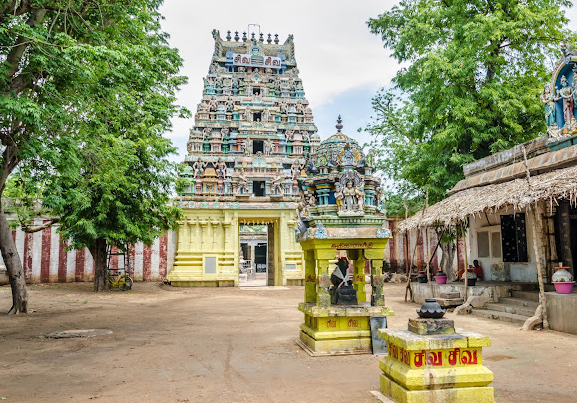ORIGIN/HISTORY:
- This is one of the 276 Devara Paadal Petra Shiva Sthalams and 2nd Shiva Sthalam in Nadu Naadu.
- This temple is a treasure trove for epigraphists as hundreds of inscriptions dating back to the ninth century are seen.
- As space was not sufficient, some of them are inscribed even on curved surfaces!! Unfortunately, latter day vandalism has shown its ugly face as well. In one of the pillars in Amman Sannadhi, while three sides contain inscriptions of the 11th century, the fourth side mentions King George Coronation.
- Lord Shiva in this temple is a Swayambhu Murti (self-manifested).
- This temple has two corridors and its main tower (Rajagopuram) has 5-tiers.
- The vimanam (roof tower) of the sanctum sanctorum has been constructed according to the Gaja Brishtam style of architecture.
- This is the birthplace of Saint Kalikamba Nayanar - one of the 63 Nayanmars and Saint Meykandar - the first of the four “Santhana Kuravars”. He is considered a pioneer of Saiva philosophy.
- Saint Marai Ganasambanthar, the third “Santhana Kuravars” is also believed to have lived here.
- The last consecration ceremony took place on 10.05.1989. Before that, the consecration ceremonies were held on 18.03.1981 and 13.07.1973.
- It is believed that this temple was built in the early Chola period. The historical names of this place are - Soundarya Chola Puram, Thiru Kadanthai, Parvathi Puram, Pushpavanam and Dhayarasapathi. The lord of this temple is praised as Sri Sudarkozhunthu Nathar and Sri Kaivazhangeesar.
- According to legend, there was once a flood which was consuming the entire world. This was the only place left that wasn’t submerged in water.
- Devas (celestial gods) rushed to this place and prayed to Lord Shiva to protect all beings by preventing the water from entering this place. Lord Shiva directed Nandhi to prevent the flood water from entering here.
- Nandhi, till then facing Lord Shiva, turned to the opposite direction, swallowed the incoming flood water and saved this place from getting submerged.
- Hence, the lord of this place is praised as “Pralaya Kaleeswarar” – “the lord who protected the world”. Nandhi, is still facing the opposite direction, that is, facing the entrance of the temple.
- Another legend is that once Indira, the king of Devas needed flowers from earth to perform Shiva puja at his abode.
- He sent two maidens to earth to bring flowers.
- Although the maidens found flowers there in plenty, they did not return back to the celestial world and instead decided to stay in this place itself after seeing a Shiva lingam here.
- They started worshipping this Shiva lingam. When they did not return, Indira sent the divine cow Kamadenu to bring them back.
- Kamadenu found the maidens but instead of taking them back she joined them in their worship of the Shiva lingam.
- When Kamadenu also did not return, Indra was perplexed and sent his white elephant Iravadham in search of them. Iravadham found them worshipping Lord Shiva and decided to join them.
- He stood near the lingam in such a way that prevented sunlight from falling directly on the Shiva lingam so as to not let the lord feel the heat of the sun.
- Finally, Indira himself came down to earth and saw everyone worshipping the lord. He also joined them in the worship.
- Later on, all of them returned together to the celestial world with the blessings of Lord Shiva.
- The name of this place “Pennadam '' is believed to have originated from this legend. “Penn'' means angel (maidens), “Aa” means divine cow (Kamadenu) and “Kada” means elephant (Iravatham).
- Another legend associated with this temple is that of Anandavalli Ammaiyar, an ardent Shiva devotee, who used to worship the lord here regularly.
- Once there was a heavy flood in the river Vellaru that prevented her from reaching the temple.
- She decided to perform her daily worship from the other bank of the river itself. Although she completed her worship, she could not see the lord. Lord Shiva realised this and as a token of his appreciation for her devotion, he raised the ground level by about 40 to 50 feet.
- Even today, the shrine is in an elevated position and one has to climb up some steps to enter it.
- Another legend associated with this temple is that of Anandavalli Ammaiyar, an ardent Shiva devotee, who used to worship the lord here regularly.
- Once there was a heavy flood in the river Vellaru that prevented her from reaching the temple.
- She decided to perform her daily worship from the other bank of the river itself. Although she completed her worship, she could not see the lord.
- Lord Shiva realised this and as a token of his appreciation for her devotion, he raised the ground level by about 40 to 50 feet.
- Even today, the shrine is in an elevated position and one has to climb up some steps to enter it.
